Vol 1 No. 19 TROPIC LIGHTNING NEWS July 8, 1966
Index
[The 1966 Vietnam issues of Tropic Lightning News were published in Saigon,
and are of lower quality than later years that were printed in Japan. Over
the years the photographs and text have faded and it has been difficult to
reproduce them. Even when the photos are unclear, I have been included
them to give a sense of the activities in the Division.]
OPERATIONS SWEEP HAU NGHIA
"Coco Palms" Nets 10
Ten Viet Cong were killed, two captured and six suspects detained last week
as 1st Battalion (Mechanized), 5th Infantry, swept through Ho Bo Woods on the
six -day Operation "Coco Palms."
The sweep netted the "Bobcats" 41 tunnels, three bunkers, 16 buildings, two
sampans and a bridge.
Additionally, 1/5th demolition teams exploded two Claymore mines, six
anti-tank mines, 44 booby traps, 20 grenades, 10 rifle grenades, seven 105mm
howitzer rounds and a 4.2-inch mortar round. They also destroyed a mortar
position, three machine gun nests and 2,000 pounds of rice.
During the six days, two M-1 rifles, one Springfield rifle, two German
Mausers, 12 Chinese carbines, three M-1 carbines, two unidentified rifles and a
Czech machinegun were captured.
The 1/5th troops captured almost 40 of tons rice, 100 pounds of salt and
1,500 pounds of peanuts.
Among the miscellaneous items found were bicycles, cloth, clothing, pick
heads, ammunition pouches, gas masks and a number of batteries.
Op "Santa Fe" Combines Dual Area Missions
Division elements, maneuvering on Operation "Sante Fe," report having killed
two Viet Cong, while capturing 20 and detaining another 49 suspects since the
operation began about three weeks ago.
The battalion has also captured or destroyed enemy bunkers, sampans,
structures, mines, booby traps and six tunnels. In addition, they captured
1,500 pounds of rice.
Area pacification has taken a large part of the units' time and effort. Army
surgeons and Army, Republic of Vietnam (ARVN), aid men have treated almost 1,400
persons while conducting Medical Civic Action Program visits.
Division soldiers are constructing roads and assisting ARVN troops in
building compounds.
Captain Milton Goo, of Honolulu, said the results are "very pleasing. The
people in the area are no longer afraid of us as they were when we arrived.
They are submitting intelligence information and the children are putting out
information on possible VC booby traps, 'dud' mortar rounds and hand grenades.
For Gallantry
Two Get Viet Medals In Pleiku Ceremonies
A veteran of three wars, Sergeant First Class Kanelio Pele, and a soldier of
14 months, PFC Philippe E. Saunier, were awarded the Vietnamese Gallantry Cross
with Gold Star and Vietnamese Medal of Honor during Heroes Day activities at the
Vietnamese II Corps Headquarters recently.
A native of American Samoa, Sgt. Pele distinguished himself by
single-handedly killing two members of an enemy machine gun crew and forcing the
other two North Vietnamese Army soldiers to flee.
Under heavy enemy fire, he carried the machine gun and ammunition, weighing
nearly 200 pounds, back to the company area.
Upon reaching his unit area, he realized a wounded man was still at the
ambush site. He moved across several hundred yards of open terrain, found the
soldier and carried him back to the company position, again receiving enemy
fire.
PFC Saunier, of Delcambre, La., was also honored for his action during the
fierce battle at landing zone 10 Alpha.
Saunier was a member of an 81mm mortar crew when Company B, 2nd Battalion,
35th Infantry, came under heavy mortar fire and intense ground fire.
He remained at his position and continued to rain mortar rounds on the enemy.
| LAUDED - Lieutenant General Nguyen Huu Co, Vietnam deputy prime minister and minister for war and reconstruction, presents the Vietnamese Gallantry Cross with Gold Star to PFC Philippe E. Saunier, 2nd Battalion, 35th Infantry, at Heroes Day ceremonies at II Corps Headquarters, Pleiku. (Photo by Martens) |
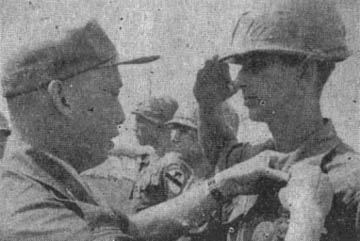 |
Special Leave Proposed For V-N Extendees
A non-chargeable, 30-day leave at the expense of the government has been
proposed for members of the U.S. armed forces in Vietnam who extend for an
additional six months beyond the normal one-year tour.
A draft of legislation to amend the present law has been sent to Congress by
the Defense Department.
The proposal requests a bill "to authorize a special, 30-day period of leave
for a member of a uniformed service who voluntarily extends his tour of duty in
a hostile fire area."
The leave would be exclusive of travel time and at an authorized place
selected by the individual.
The bill also notes that transportation will be provided to and from the
place of departure. (AFNB)
|
Chief Visits |
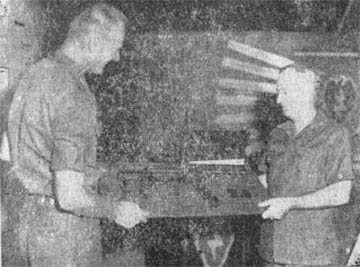 |
| CINCPAC - Major General Fred C. Weyand, division commander, presents a captured Chinese sub-machinegun to Admiral U.S. Grant Sharp, commander-in-chief, Pacific. Admiral Sharp visited Cu Chi as part of an inspection and familiarization tour of Far East facilities. The admiral, accompanied here by General William C. Westmoreland, commander, U. S. Military Assistance Command, Vietnam, also visited Cam Ranh Bay Air Base and the III Marine Amphibious Force's 35th Tactical Fighter Wing at Da Nang. (Photo by Park) |
AF CG Visits 25th; Goes to Hawaii Job
Air Force Lieutenant General Joseph H. Moore, the former commander of the 7th
Air Force (Vietnam), stopped at Cu Chi late last month as part of his farewell
tour.
Gen. Moore, in command of the 7th Air Force for more than two years, is the
new deputy commander, Pacific Air Forces at Hickam Air Force Base, Hawaii.
Air Force Lieutenant Colonel Henry A. Jones, U.S. Air Force liaison officer
to the division, led a contingent of Air Force personnel stationed at Cu Chi to
greet the general.
The general staff and Air Force personnel attended a briefing by General
Weyand on the state of the division - past, present and future.
During Gen. Moore's two years in command of the 7th Air Force, he has seen
the U.S. air element grow from a handful of World War II bombers, with advisors
at the controls, to the present massive capability of the latest flying weapons
systems.
Gen. Weyand presented Gen. Moore with a captured Chinese Communist
sub-machine gun, taken during the recent Operation "Makiki." The weapon was
mounted on a plaque expressing the division's thanks for the air support
provided repeatedly.
Gen. Moore has been succeeded at the 7th Air Force by Lieutenant General
William W. Momyer.
(See picture page 8)
Small-Unit Tactics Pay Off
One thing that American troops have learned from the war is that it can't be
fought conventionally. What seems to characterize the fighting in this conflict
is the reliance on small-unit tactics.
There is perhaps nobody as qualified to discuss the utilization of small
units as a company commander.
First Lieutenant Thomas H. Snyder, St. Joseph, Mo., is the executive officer
of Company C, 2nd Battalion, 35th Infantry. The day before the company was to
begin an operation, the company commander became ill and Lt. Snyder became
acting commander. He learned first hand the importance of the small unit.
Explaining the use of the tactic, Lt. Snyder said, "It is extremely hard for
even a company to move through the terrain in Vietnam and really expect to make
some sort of contact because a large force is easy to detect and easy to evade."
"I think most contact occurs when a small platoon or squad-size unit is
used."
Lt. Snyder explained why small patrols have proved effective.
"When a small patrol is sent out it gets artillery concentrations, armor to
support it, radios, good communications, and medical supplies."
"In one instance our reconnaissance platoon went out on an operation and hit
a little bigger force than was anticipated. Within about five minutes there
were four Thunderchiefs in the air, bombing positions in front of them, and
about 150 rounds of artillery being thrown at the enemy."
Page 2 TROPIC LIGHTNING NEWS July 8, 1966
Decorated
| BRONZE STAR MEDAL (With "V" Device) | |
|
Sp4 Ronald E. Ange, Co. A, 2/14th Inf. 2nd Lt. Richard D. Clark, Co. B, 1/77th Inf. Sp5 Billy D. Crumbley, HHC, 4/23rd Inf. Sp5 Paul Derico, HHC, 1/5th Inf. 1st Lt. Frederick H. Henderson, Co. B, 1/27th Inf. |
Sp5 Jerry 0. McBryde, HHC, 1/5th Inf. Sgt. Nathaniel Merriweather, Co. A, 2/27th Inf. Sp4 Gregory B. Norton, Co. B, 2/27th Inf. PFC Joseph Pecora Jr., Co. C, 1/27th Inf. PFC Lloyd G. Wiegel, Co. B, 2/27th Inf. |
| AIR MEDAL |
|
|
Sp5 William E. Boone, Co. B, 25th Avn. Bn. Sp4 Chabes R. Burnett, Co. B, 25th Avn. Bn. Maj. Frank E. Deam Jr., HH&S Btry., 1/8th Arty. Maj. Earnest C. Elliott, Co. A, 25th Avn. Bn. Maj. Glenn T. Feilke, HHD, 25th Avn. Bn. Sp4 Melchoir Gonzales, Co. B, 25th Avn. Bn. Capt. Robert H. Kelly, Co. B, 25th Avn. Bn. Capt. Duane F. Kockx, HHD, 25th Avn. Bn. |
PFC Walter H. Phillips, Co. B, 25th Avn. Ba. Capt. William F. Prow, Co. B, 25th Avn. Bn. Maj. Peter P. Seaton, Co. A, 25th Avn. Bn. Capt. James R. Talbert, Co. B, 25th Avn. Bn. Maj. James R. Vance, Co. B, 25th Avn. Bn. Sp5 James B. Wiley, Co. B, 25th Avn. Bn. Sp5 Vernon H. Woods, Co. B, 25th Avn. Bn. |
| ARMY COMMENDATION MEDAL (With "V" Device) |
|
|
PFC Jimmy Cosley, HHC, 4/23rd Inf. Sp4 Joe E. Douhly, HHC, 4/23rd Inf. SSgt Purvis E. Hamm, HHC, 4/23rd Inf. |
SSgt Robert L. Harris, HHC, 4/23rd Inf. Sp4 Robert E. Walters, HHC, 4/23rd Inf. |
| PURPLE HEART |
|
|
PFC Clarence C. Biddle Jr., HHC, 2/14th Inf. PFC Charles L. Boling, HHC, 2/14th Inf. PFC James E. Cole, Co. B, 2/27th Inf. PFC Frederick L. Collins Jr., Co. B, 2/14th Inf. PFC Earl W. Hornung Jr., A Trp., 3/4 Cav. PFC James L. Ledin, Co. C, 2/27th Inf. PFC David H. Lowrie, Co. B, 65th Engr. Bn. PFC Roger R. Mariani, HHC, 1/27th Inf. PFC Lorenzo C. Maulden, A Trp., 3/4 Cav. |
PFC Roy L. Pellette Jr.. HHC, 2/14th Inf. PFC John A. Perkins, Co. B, 2/27th Inf. Sp4 Robert Reedom, Co. A, 4/9th Inf. Sp4 Richard G. Renaud, B Trp., 3/4 Cav. Sp4 Ramon L. Reyes-Rodriguez, Co. B, 65th Engr. PFC Antonio O. Salazar, B Trp., 3/4 Cav PFC James R. Smith, HHC, 4/9th Inf. PFC Robert Weekes, Co. A, 1/5th Inf. PFC Arthur L. Williams Jr., Co. A, 2/14th Inf. |
"Defending Freedom Safeguards America"
"I know that when my Country calls I must go. For each time the aggressor
stalks the weak, and goes unchallenged, the hobnailed boot of oppression treads
one step closer to me and mine."
Technical Sergeant Gerard R. Eder, USAF, wrote the above lines. They were
included in his 500-word letter, "I am an American," to Freedoms Foundation last
year.
And now it's time for the 1966 Freedoms Foundation Letter Awards Program.
As a serviceman or woman on active duty, you are included in this program.
You too can win a cash prize and a trip to Valley Forge, Pa.
Here are the simple rules. The subject this year is: "Defending Freedom
Safeguards America." Write or type no more than 500 words on this subject, using
only one side of the paper. Be sure to print or type your name, rank, military
address and home address. Mail entries to Freedoms Foundation, Valley Forge,
Pa., 19481. The deadline is Nov. 1, 1966.
The top award is $1,000. There are 50 awards of $100, 50 more of $50.
Runners-up will receive the George Washington Honor Medal or Honor Certificate.
What is the Freedoms Foundation? Basically, it is an independent, nonprofit
organization not affiliated with any sectarian religious group or political
party, dedicated to creating and building an understanding of the spirit and
philosophy of the Constitution and the Bill of Rights.
(AFNB)
Drive Pushed Until July 31 For Army Aid
The division's 1966 joint fund campaign for Army Emergency Relief (AER) and
Army Relief Society (ARS) will run through July 31.
The AER, ARS are designed to aid active personnel, retired soldiers and their
families in times of financial distress.
Captain Richard M. Smith, chief of the division Personnel Actions Branch, has
been designated division projects officer. Commanders have designated unit
project officers down to company, battery, troop and detachment level.
Contributions, in either U.S. military payment certificates or Vietnamese
piastres, will be made on a voluntary basis. No participation goals have been
set.
Correspondence
The military services sponsor about 33 correspondence school centers. The
largest is the United States Armed Forces Institute, Madison,Wis.
Ex-Cong Sings Song Of Terror
Although few, except those immediately affected, realized the war was on in
the late 1950's and early 1960's, those who were the victims of the savage
campaigns of terrorism, assassination and kidnapping in rural Vietnam were well
aware of it. So, too, were the thousands of cadres - trained, dedicated,
hard-core Communist leaders and military officers - who fanned out in the
countryside to win support for the insurgent forces.
A cadre's role can be described as a combination priest, policeman and
propagandist. He is the Communist Party and the National Liberation Front in
the countryside hamlets and villages. How they operate is graphically described
by one of them, Captain Lam.
"We seek to do three things. The first is to drive a wedge between the
people and their government - to make the people hate their government and the
Americans. Our second objective is to get people to join our armed forces. The
third is to persuade them to increase their production of food and give the
increase to us.
"Our cadre go into each village to study the situation and the people. Once
they know the people and their problems, our cadre can explain how the problems
are the fault of the government, and how the people can achieve their ambitions
by following us. In this way we make the government in their village. Then we
guide them in forming their own government and in organizing their own armed
forces, which, of course, are our auxiliaries.
"Of course, we cannot do this right away in those villages and districts
where the government is strong. There we concentrate on educating people
politically to hate their government, and on forming both open and secret
organizations, which can support us or embarrass the government. Every little
bit helps. Any voluntary action of the people, from organized protest to simply
slowing down on work ordered by the government, is a clear gain for us.
"Our cadre live in the village or if this is not safe very close by. They
appeal to the ideals, the patriotism and the emotions of each individual
according to his situation and try to recruit him for the cause. If a person is
arrested by government forces we try to contact him as soon as he is released,
sympathize with him, arouse his hatred of the government and recruit him. Many
times we bring hungry, tired troops into a village so that the people may see
how we are suffering for them, and arouse their sympathy. We try in every
possible way to create hatred for the government and the Americans, to separate
the people from the government and to make them see that we are their only hope.
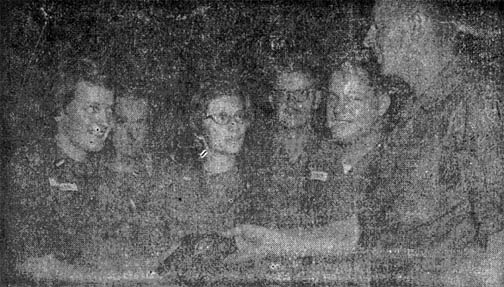 |
OUTSTANDING HELP - Major General Fred C. Weyand, division commander, presents an appreciation plaque to ward nurses. 1st Lieutenants Donna M. Vallee and Vane E Fritzges for the outstanding medical care given to division personnel. (Photo by Park) |
| The TROPIC LIGHTNING NEWS is an
authorized publication of the 25th Infantry Division. It is published
weekly for all division units in the Republic of Vietnam by the
Information Office, 25th Infantry Division, APO U.S. Forces 96225. Army
News Features, Army Photo Features and Armed Forces Press Service material
are used. Views and opinions expressed are not necessarily those of the
Department of the Army. Printed in Saigon, Vietnam, by Dai Doan Ket
Publishing Company. Maj. Gen. Fred C. Weyand . . . . Commanding General Maj. William C. Shepard . . . . . . Information Officer 2nd Lt. Patrick J. McKeand . . . Officer-in-Charge Sp5 Dale P. Kemery . . . . . . . . . Editor PFC David L. Kleinberg . . . . . . Editorial Assistant |
Page 3 TROPIC LIGHTNING NEWS July 8, 1966
Buffalo, Bulls Bully . . .
The water buffalo, as much a part of Vietnam as the Vietnamese themselves,
has a temper that at times is comparable to that of the waterlogged Viet Cong.
They have been known to charge soldiers on patrol and be generally as nasty
as possible to American fighting men who may cross their trail.
However, the sight of three of the animals, stuck up to their backs in the
mud and mire which usually follow a monsoon storm, was more than enough to
attract the sympathy and immediate concern of at least one such American
fighting man.
Staff Sergeant William E. Cunningham, of Junction City, Kan, has become known
to the men of the 4th Battalion, 9th Infantry, as "the matador of the rice
paddies."
Sgt. Cunningham, who is in the reconnaissance platoon, spotted the three,
grey oxen engaged in a hopeless struggle to free themselves, just outside the
4/9th portion of the division perimeter.
After a minimum of red tape, Sgt. Cunningham was granted permission to take a
small group of men, equipped with some strong rope, and go outside the wire
barrier. To the group's surprise, one of the animals already had wriggled free
and had fled the scene. This left two: a cow and her calf.
It was reasoned that the calf should be removed first since no one knew how
much mama would cooperate once she was back on solid ground.
The baby was pulled out and lost no time scampering away. Attention was then
turned to the mother. Ah, the mother. Someone said she looked as heavy and as
mean as an M48 tank.
There were sighs of relief and exhaustion when the cow was finally hoisted
out "Ground floor, cosmetics, ladies apparel, corsets," someone joked as the cow
ambled away.
"Well," said Sgt. Cunningham, "maybe one of these days we'll be out on an
operation and there'll be a water buffalo blocking our path. It just could be
that she'd remember us and save us a lot of aggravation by just moving out of
the way."
Could be.
. . . And Wallow
Recently 3rd Brigade announced that it had enough armored vehicles to fill a
football field if they were parked side by side and end to end.
Last week, men of 1st Brigade discovered that the Viet Cong also have quite
an armor capability - of sorts.
Wading through the rice paddies on a search-and-clear mission, men from 2nd
Battalion, 14th Infantry, cautiously approached a wooded hedgerow. After
checking for booby traps, the point man of the patrol suddenly stopped cold as
he was picking his way through to the next paddy.
Lined up in battle formation was an entire company of "VC armor," poised to
attack the advancing infantry as soon as the soldiers emerged into the clearing.
The almost armor was a herd of Vietnamese bulls and they were all quite put
out by the noise of constant artillery and small arms fire in the area. Most of
then had a healthy set of horns. One was not tied up.
The loose bull spotted the point man and the chase was on. The soldier was
well trained in hand-to-hand combat, but man-to-bull fighting was different.
Missing on the first charge, the bull came around again and caught the trooper
head on.
Enough was enough - this beast definitely wasn't a "friendly". The platoon,
now coming into the field, avoided the animal as it prepared to charge again.
Assisting its buddy to his feet "his pride had been seriously injured" the
patrol continued its search, walking gingerly past the other incensed - but
leashed - bulls.
Later at the patrol debriefing the matter of the "new" VC capability was
discussed.
While a few of the men felt that the bulls were simply farm animals belonging
to friendly local people, the thought that the bulls were especially trained
guerrillas placed by the VC to harass the U.S. forces in the area was voiced by
the majority, especially one man with a very sore pride.
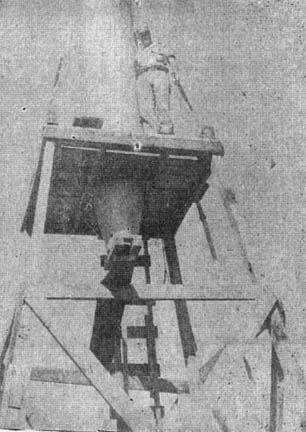 |
BLAST OFF - Captain Daniel R. Leonard is dwarfed by the 35-foot aviation water rocket on Cu Chi Launch Pad Number One. (Photo by Park) |
25th Avn. Shower Is New "Way Of Life"
There are 50-gallon drums and five-gallon cans. There are urns and there are
rude tubs. Showers all.
And then there is Cu Chi Launch Pad Number One, which is more a way of life
at 25th Aviation Battalion than a mere shower.
Looking askance at their old Water system, the aviators decided it was time
to introduce a little more sophistication to their body-cleaning,
whisker-removing process and they worked day and night for more than six weeks
to get it.
The Launch Pad, looking not unlike a confused bomb, is a retired airplane
wing fuel tank, standing on end, towering 35 feet in the air. The watery
storehouse for the battalion's Headquarters and Headquarters Detachment, the
tank contains 425 gallons of Clean.
Five times a day, a tiny, gasoline engine-driven pump sucks water from a
40-foot-deep well, which is lined with steel casing and filled with hand-crushed
granite gravel to filter the water. At the bottom stands 1,500 gallons of free
water.
For their effort, the men of the detachment now have running water in front
of every other hut, as well as all the water they can use to shower with in
their newly completed shower room.
Captain Daniel R. Leonard, of Honolulu, Hawaii, says, "The water pressure
coming out of the shower is almost strong enough to scratch your back."
Capt. Leonard, the detachment commander, credits the whole installation to
the unit's former first sergeant, Billy G. Hicks, who first suggested the well
and underground pipe complex that has blossomed into one of the best makeshift
water systems at Cu Chi.
The pipes were buried for esthetic reasons, but it was a back-breaking chore
to bury more than 500 feet of pipe. Now the men can afford to laugh it off as
an attempt to prevent freezing.
Cu Chi Shuttle Bus System Operating
Cu Chi now has a shuttle bus.
The Aloha Transit, Far East Route bus, operated by the 25th Supply and
Transportation Battalion begins operation at 9 a.m. daily and runs continuously
until midnight.
The bus makes 28 stops, including the various battalions, the Ilikai East
service club and the hospital. The entire circuit takes about one hour.
The addition of the bus service is expected to ease the division's critical
transportation problem.
|
Bus Schedule |
|||||||||||||||||||||||||||||||||||||||||||||||||||||||||||||||||||||||||||||||||||||||
|
Women V.C. Snipe At GIs
The American soldier may have affection for his girl friend,
fiancée, wife,
sister, mother, etc., but he has little for the female sniper in Vietnam's
treelines.
During Operation "Fort Smith," a recent search-and-destroy mission, a
company began receiving sniper fire.
As the snipers fled their positions, they were observed to be women, although
none was captured.
It appears that now there are "Charlenes" as well as "Charlies" to contend with.
Youth Finds "Fire Inna Ho"
"Fire in the hole" Sergeant Jerry Whitehead, Tallahasse, Tenn., yelled his warning at least 86
times while on a recent operation six miles southwest of Cu Chi.
Sgt. Whitehead, a 21-year-old team leader with the reconnaissance platoon of
the 1st Battalion, 27th Infantry, yells the warning before blowing up
booby-trapped hand grenades and "dud" mortar rounds found in the area of
operation.
Most of the explosives remain from an Army, Republic of Vietnam (ARVN),
Ranger outpost overrun in December 1965. All but a few were found by Vietnamese
children in the area, responding to the American soldiers' offer of rewards for
such information.
"About a week and a half ago I was securing the road here when a Vietnamese
boy came up and pointed toward a field," said Sgt. Whitehead. "I followed, and
sure enough there was a grenade. I gave the kid a cigarette and ever since it's
like an Easter egg hunt but now we give them C-rations."
Meanwhile, Sgt. Whitehead put another charge on an explosive and ran without
giving his warning. He didn't have to.
"Hey GI," a young boy yelled, "fire inna ho."
Page 4 - 5 TROPIC LIGHTNING NEWS July 8, 1966
Daring Men In Their Flying Machines
The division motto, "Ready to Strike - Anywhere, Anytime," also stands for
the mobility, speed and shock power provided by 25th Aviation Battalion,
commanded by Lieutenant Colonel Edward P. Davis, of Warren, Ark.
It takes extensive planning and coordination to enable division soldiers to
move faster and hit harder than ever before.
Before the "slick" (troop-carrying helicopter) touches down in the landing
zone (LZ), much discussion and many conferences have taken place.
With the pace of operations never slowing, several heli-lifts are in some
stage of planning at any given moment. When the operations order is received
from division headquarters, the aviation battalion operations officer, Major
Charles R. Standidge, of El Paso, Tex., coordinates with his counterpart in one
of the infantry brigades to arrange dates, time of lifts and units of the
brigade to be lifted.
One or two days before the planned lift, an aviation battalion liaison team
contacts the platoon, company or battalion to be lifted to determine the number
of spaces needed, exact locations of pick-up and landing zones and fire support
coordination.
Finally, with all details assembled, the aviation operations order is
written.
Company A, the "Little Bear" of 25th Aviation, is directed to provide the
necessary number of slicks for the lift. Major Ernest C. Elliott, of Florence,
S.C., the company commander, has a fleet of UH-1D "Huey" helicopters to draw
from. When large lifts require additional choppers, requests for support are
submitted to higher headquarters.
Armed helicopter "gun ship" support comes from Company B, commanded by Major
James R. Vance. Most of his aircraft are equipped with dual rocket pods, with
seven rockets each and "double-barreled" machine guns. In addition, the door
gunners use machine guns. The other choppers carry grenade launchers and door
guns.
Depending upon the resistance expected in the landing zone and the size of
the heli-lift, "light" or "heavy" fire teams are assigned from B Co.'s "Diamond
Head" aircraft. The light fire teams consist of rocket-equipped choppers while
the heavy team has an additional, grenade-equipped Huey.
As late as an hour prior to the assault, the aircraft commanders and flight
leaders are gathered for a briefing on the lift. The timing, routes, no-fire
zones, condition of landing and pickup zones are discussed in detail, as are
radio frequencies and call signals.
First to take off are the gun ships. They are followed by the command and
control (C&C) ship, the slicks and finally, the maintenance chopper.
The gun ships and C&C craft move in advance of the choppers to reconnoiter
the proposed landing zones and make final adjustments in the plan.
Aboard the C&C ship are the commander of the unit to be lifted into battle,
and air and artillery liaison officers. Extra radios installed in the special
ship enable the commander to talk to his ground units and the air and artillery
controllers to direct supporting tactical Air Force or artillery fire.
The maintenance ship flies high above, and to the rear of, each flight.
Should any of the other Hueys be downed the machine guns mounted aboard the
trailing ship offer protection for the damaged aircraft. When gun ship support
arrives, maintenance craft lands near the downed helicopter. If the downed
craft is beyond immediate repair, the maintenance ship helps to provide cover
until a CH-47 "Chinook" can be called in to extract the ship. The maintenance
ship lands only in case of trouble.
With C&C, gun ships and maintenance ships circling overhead, the slicks drop
into the pickup zone. The infantrymen are waiting in groups, already assigned
to aircraft. The rotors barely slacken their speed. In seconds, the men are
loaded and once more the flight lifts off.
Now the gun ships move slightly ahead. The LZ can be seen from far away as
clouds of smoke from the artillery and air preparation billow up. Before the
smoke clears the gun ships are once more over the area, cutting loose with their
rockets and grenades.
Any uninvited occupants of the LZ barely have a chance to come up for air
when the flight descends. In the time it takes to blink an eye the troops are
on the ground completing the assault.
The flight returns to the pickup zone as many times as needed to lift the
unit into battle. Each time the procedure is the same. Overhead the C&C ship
coordinates the lifts, granting return fire permission to the gun ships and
giving instructions for trailing lifts to orbit if a preceding lift is tied up
on the LZ.
Once all the infantry is on the ground, the choppers, return to Cu Chi. Back
on the ground, fuel tanks are refilled, ammunition is replaced and maintenance
is performed.
Later in the day, perhaps only minutes later, the ships will be called on
again to provide resupply to the ground forces. An emergency might require an
unplanned lift on little notice.
None of the pilots knows when the work will end, but the men the of division
feel strongly that it will end sooner because of these pilots and their crews.
|
25th Inf. Div. Photos by |
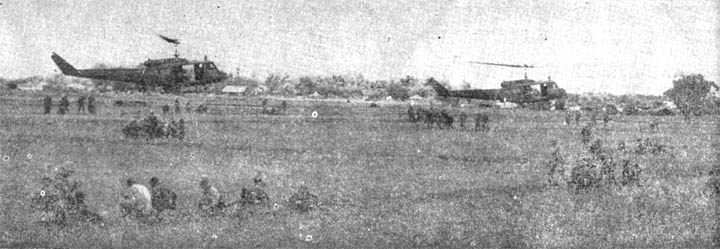 |
| "Little Bear" helicopters from Company A, 25th Aviation Battalion, lift off from pickup zone during combat assault in operation "Fresno." |
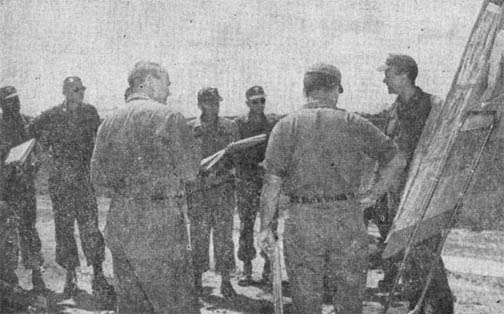 |
| PLANNING - Major Graham C. Davis (r), operations officer for 25th Aviation Battalion's Company A, briefs a group of aviators prior to an assault lift. Observing the briefing are (from left) Major Jesse M. Burch (back turned), Major Hughey L. Weston, Major Peter P. Seaton, and Major Ernest C. Elliott (back turned). |
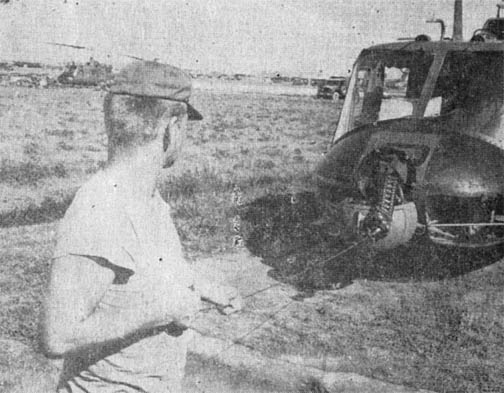 |
| PREPARATION - Specialist Four Jeffrey Adams, Company B, 25th Aviation Battalion, pulls belt of 40mm grenades through M-5 grenade launcher mounted on one of company's eight "gun ships." |
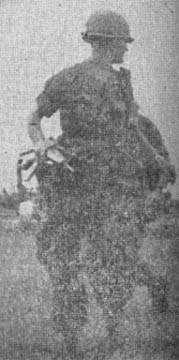 |
AFTER THEM! - Captain Cedric L. Blackwell, an officer of Company A, 2nd Battalion, 27th Infantry, leads a group of his men in an airmobile combat assault on Operation "Fresno." |
| BEGINNING - "Little Bear, helicopters drop into pickup zone during combat assault. |
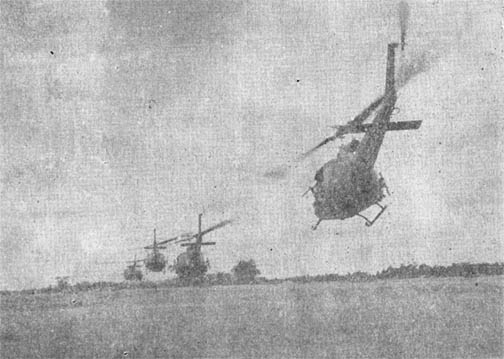 |
Page 6 TROPIC LIGHTNING NEWS July 8, 1966
Medical Civic Action Program
|
|
2/14th Treats 350
The 2nd Battalion, 14th Infantry, treated more than 350 people in a Medical
Civic Action Program visit and distributed more than a ton of "Helping Hand"
items in a recent operation.
Members of the 14th Infantry's medical platoon and support and administrative
platoon moved into the village of An Binh, northwest of Cu Chi, to give medical
aid to the ill, distribute toys to the children and clothes and food to the
adults.
Before the aid station could be set up in the rear of an armored personnel
carrier, people were standing in the door, waiting for treatment.
Captain Warren V. Helwig, Alexandria, Va., made himself comfortable in his
small clinic and began treating the hundreds of people that had by now gathered
around him.
Specialist Five Robert G. Willson, Salem, Ark., a medical technician, along
with other members from the "Golden Dragons" medical platoon, treated minor cuts
and bruises.
After the people were treated, they received clothes and food from the
members of the support and administrative platoon. The food was provided by the
mess halls and individual battalion soldiers, and the clothes and toys came from
"Helping Hand."
Support and administrative platoon sergeant James D, Spitz, Hutchinson, Kan.,
provided clothes that he had brought from Hawaii to give to the people of
Vietnam.
After lunch the team moved to An Duc. First Lieutenant Curtis V. Ebitz,
Pittsburgh, Pa., in charge of civic action for the 14th, said this was one of
the largest battalion civic action projects since the program began in May of
this year.
Security for the operation was provided by Company A, commanded by Captain
George P. McQuillan, Bethesda, Md.
"Bac Si" Bribes Kids; Toys Produce Shots
By CAPT. WILL R. GOODRICH
"Bac si, bac si," the word flashed by village grapevine for it was Saturday
and time for the American MEDCAP team to arrive.
The "bac si" (doctor) had arrived and was ready to set up in the village
school of Ap Phu Trung to treat the people of Ap Ben Do hamlet. No loudspeaker
trucks and no leaflets were needed, for the people of Ap Ben Do had come to know
the division Medical Civic Action Program.
Silently they came, down the road and across the rice paddies. Young, old,
sick, curious; they came to see the "bac si". Gone were the reluctant frowns
that first greeted the MEDCAP team from the 1st Battalion (Mechanized), 5th
Infantry, many weeks ago. There were smiles and soft words for old friends.
"Where's my friend, the Village chief ?" asked 1st Sergeant Robert Carmack,
from Atchison, Kan.
A young man stepped out from the gathered villagers, anxious to try his newly
learned English, "He is gone Cu Chi, come back soon to see you."
"Well, we'll go ahead as we have a special surprise for the children," said
Sgt. Carmack, the 1/5th civil affairs sergeant.
The special surprise was soon unpacked along with the a medical kits,
stretchers and medicines. It was a box of many-colored, stuffed animals, a gift
from the home economics class of McKinley High School, Honolulu.
As the afternoon wore on prescriptions for vitamins, aspirin, soap,
penicillin shots and other medicines were joined by prescriptions for a stuffed
toy animal to right the eyes of a little girl or boy. When the short afternoon
ended, over 80 villagers had been seen and treated by the two doctors.
Wolfhound Visits Pass 1,000 Mark On Opn. Fresno
More than 1,000 persons have been treated by Medical Civic Action Program (MEDCAP)
visits as a battalion of the 27th Infantry "Wolfhounds" moved toward the
one-month mark of Operation "Fresno."
Since the start of the operation, designed to concentrate heavily on civic
action, the "Wolfhounds" have conducted MEDCAPs in more than 16 hamlets.
"Helping Hand" has also aided more than 700 villagers, who have received
toys, clothes and health and sanitation items.
Manpower
Department of Defense makes a substantial contribution to the nation's
skilled manpower pool. Some 96 per cent of enlisted personnel and 84 per cent
of officers retire in time to pursue a second career.
| FAT CHANCE - Everyone at Ap Phu Trung wants a pencil, but First Sergeant Robert Carmack of Atchison, Ken., is determined to see that they are passed out in an orderly fashion. (Photo by Hanson) |
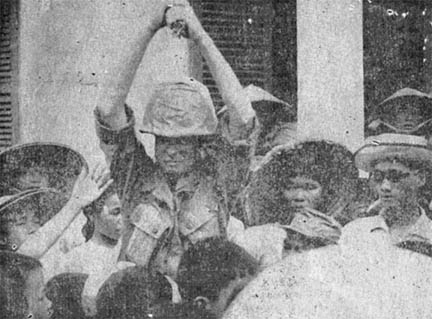 |
Page 7 TROPIC LIGHTNING NEWS July 8, 1966
65th Engrs. Build Chapel
The myriad sounds of construction are quite familiar to the men of the 65th
Engineer Battalion. But the crunching shovels and banging hammers heard now
within their own midst are shaping something very different.
The building's radical construction immediately draws the eye from
surrounding tents. One's imagination conjures up a variety of images until the
rows of pews are seen nearby.
The chapel is one of the first being built at Cu Chi. A second is now under
construction at 3rd Squadron, 4th Cavalry.
It may be coincidental that the chaplain serving both units is the same man
Chaplain (Capt.) Alfred Delossa Jr., of North Bridge, Calif., known as the
division's "construction chaplain."
The lack of chapels in the base camp can be attributed to the construction
priority list, which numbers about 60 structures necessary to a smoothly
organized camp. Permanent chapels are low on the list.
Religious services in the 65th have been held in the company mess and
outdoors in the pews that were shipped to Vietnam with the battalion. Chaplain
Delossa said the men felt they "ought to have a special place to worship."
The chaplain received a number of volunteers willing to work on a chapel
during their free time so he went about securing materials. A fund, which now
totals over $400, was established, and the chaplain took off for wherever he
could obtain building materials.
So far no money has been spent on the chapel. Chaplain Delossa said that he
got help from the Army, Air Force and Navy in his effort. The actual
construction has been going on for three weeks, with the completion date
scheduled for early August.
So far the volunteers have laid a laterite base, raised the beams and
prefabricated the ceiling to be placed on the beams.
The chapel was designed around the pews already being used by the 65th from
plans drawn by 2nd Lieutenant Ronald E. Heck, of Twin Falls, Idaho.
Of a modern design in keeping with an open-air effect, the chapel will be 42
by 62 feet. It will be landscaped by greenery in three foot high planters, which
will surround the building, the entrance and the altar.
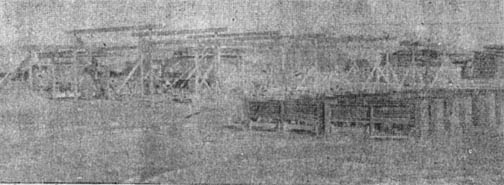 |
| WORSHIP - The pews at the right are the clue to the type of building being constructed at 65th Engineer Battalion. Materials for the chapel were donated by the Army, Air Force and Navy. The labor is being performed by volunteers from the 65th. (Photo by Park) |
3/4 Cav. Gets VC Pony
Gone are the days when the cavalry took to the field mounted on their fiery
steeds.
Recently, however, a moment of that history was relived when Captain W.E.
Cunningham, of the Special Forces detachment at Duc Co, presented a pony to C
Troop, 3rd Squadron, 4th Cavalry,
This is a very special pony because, prior to May 29, it was the property of
a North Vietnamese colonel.
On May 28, Trp. C, under the command of Captain W. E. Duffer, was attached to
3rd Brigade's 2nd Battalion, 35th Infantry, operating in an enemy-infested area
north of Duc Co. Contact with the North Vietnamese was heavy, and at dark the
enemy elements withdrew to the west side of the village of Plei Brens.
The following morning the cavalrymen surrounded the village and in went Capt.
Cunningham and his Special Forces strike force to search the village.
During the search, the captain discovered a black pony.
Interrogation of the village chief revealed that a North Vietnamese Army (
NVA ) colonel had left the pony, saying that the villagers were to care for it
until he returned.
Realizing that the pony would make a better mascot for Capt. Duffer's cavalry
troops than transportation for the NVA colonel, Capt. Cunningham confiscated the
pony. In the animal's place Capt. Cunningham left a note for the colonel that
the pony could be claimed by him or his friends if they would appear in person
at the Duc Co Special Forces camp, Pleiku Province.
Then, thanks to a helping hand from the 52nd Aviation Battalion, the pony was
helilifted to Duc Co where it made its temporary home for the next three weeks,
leisurely grazing around the camp under the ever watchful eyes of the "Green
Berets."
Finally, the reunion day arrived. Trp. C was once again committed to action
in the Duc Co area. As the troopers rolled into Duc Co, dust clouds billowing,
they were delighted to see their mascot awaiting their arrival. With the
cavalry troopers and strikers cheering, the little pony passed in review for its
new unit, the U.S. Cavalry.
There has been no word from the upstaged NVA colonel.
| HEY, HOSS ! - Specialist Four James H. Nail Jr., Duck Hill, Miss., a member of Troop C, 3rd Squadron. 4th Cavalry, at 3rd Brigade rides the troop's mascot after picking up the mail. (Photo by Sutphin) |
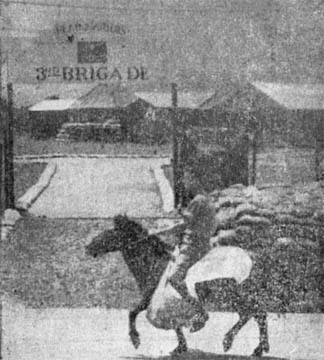 |
4/9th Hit, Recovers
Four of the five men in the patrol were wounded; the fifth a machine-gunner,
was making the Viet Cong wish they had never started the ambush in the first
place. But this was no time to wish it hadn't started. The bullets were coming
in fast and furious; the enemy had the jump on them.
It all started when the first platoon of Company B, 4th Battalion, 9th
Infantry, was conducting a search-and-destroy operation just outside Cu Chi.
In the early morning hours, they set up their command post (CP) about 2,000
yards from the base camp perimeter.
Two squads of the platoon were to sweep a pre-designated area, while the
balance of the platoon was to remain at the CP as a reactionary force. One of
the squads split into two, five-man fire teams, and the groups set out.
The first half of the sweep saw only light contact, but yielded one enemy
casualty. The team proceeded further. Two suspects were spotted and captured.
Returning to the CP the seven-man unit passed within ten yards of a VC-infested
trench and spider hole network.
As in any well-planned ambush, the Viet Cong waited until the last possible
moment before they opened fire. This tactic proved difficult for the 4/9th but
was much harder on the V.C.
Rather than accept defeat, the Americans, many of them wounded, aggressively
charged the surprised VC.
The radio telephone operator, although wounded, managed to radio that the
team had been hit. That was enough for the rest of the squad. They knew their
comrades position and lost no time coming to their aid. The fighting continued.
In the end, nine V.C. lay dead.
25th, ARVN Assault Ho Bo Woods
A multi-company force of Vietnamese soldiers took part in a heliborne assault
conducted by the division recently in Ho Bo Woods.
Units of the 3rd Battalion, 49th Regiment, 25th Infantry Division
(Vietnamese), were airlifted by the U.S. 25th Aviation Battalion. They had
worked in close coordination with American units already in the Ho Bo Woods.
Ho Bo Woods, long a VC stronghold, has come under increasing pressure in
recent weeks from division units. The operation is another in a series of
search-and-clear missions designed to return the disputed area to friendly
control.
The air lift was accompanied by a number of heavily armed weapons ships from
the 128th Assault Helicopter Company stationed at Phu Loi, 35 miles from Cu Chi.
American military advisers, who accompanied the Vietnamese in the field, had
high praise for the units, saying they were "some of the sharpest" they had
seen.
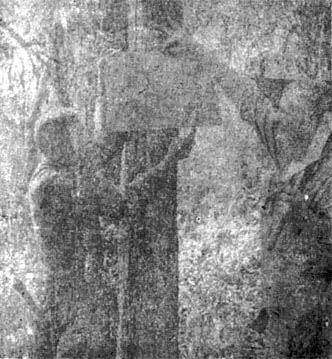 |
NYAHHH! - Captain Ora L. Boss (right), commanding officer, Company A, 1st Batlalion, 14th Infantry, and 1st Sergeant Yashiiwa Nagato, tack up a sign indicating two (in Roman numerals) VC "met their maker." The company has taken to advertising its presence through such signs - much to the VC's chagrin. (Photo by Blue) |
Page 8 TROPIC LIGHTNING NEWS July 8, 1966
| Vietnam Communique... A weekly summary of major Army actions in the Republic of Vietnam compiled by Army News Features from Department of Defense published Official MACV Communiques. June 23 through June 29, 1966 1st Cavalry Division (Airmobile) - (See 101st Airborne Division account of
1st Cav. participation in Operation Nathan Hale.) |
At Cu Chi
Fuel Tanker Catches Fire
A 1,200-gallon tanker caught fire recently in the fuel storage yard at the
division base camp.
The truck, driven by Specialist Four Donald Shatto, Claremore, Okla, a member
of Company A, 25th Aviation Battalion, caught fire as he started the engine
while preparing to leave with a full load of JP4 jet fuel.
The cause of the blaze has not yet been officially determined, although it is
thought that overflow plugs leaked a small amount of fuel onto the exhaust pipe,
causing it to ignite.
Second Lieutenant David C. Whitcomb, of St. Paul, Minn., officer in charge of
the fueling area, said the fire raged for a half hour.
"The truck just finished fueling from a 10,000-gallon, collapsible tank when
the fire started," he said. "If that tank had blown it could have caused a
chain reaction, igniting all the other tanks in the area. Six, 15-pound fire
extinguishers were emptied in an attempt to put out the blaze before a fire
truck arrived a few minutes after the fire started."
All tank truck drivers closed the hatches of their vehicles and left the
vicinity of the fire. Road blocks were set up on Taro Road, where the fuel yard
is located.
PFCs Woodrow Barr, of New York City, and Samuel Stoles, of Pine Hill, Ala.,
stayed behind in a vain attempt to quell the blaze before the fire truck
arrived.
After the fire was brought under control, a wrecker towed the smoldering
truck to a secluded area and a 5,000 gallon water trailer was sent to cool the
vehicle.
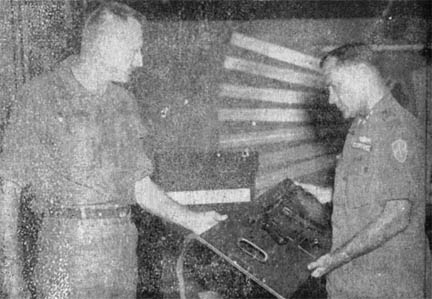 |
Major General Fred C. Weyand, division commander, presents a captured Chinese sub-machine gun to Air Force Lieutenant General Joseph H. Moore, (former 7th Air Force commander, during General Moore's farewell visit to Cu Chi. (Photo by Park) |
The 'Air-Born' Pets
Pets in Vietnam are not unusual, but few units have pets that are "air-born."
A Company, 1st Battalion, 14th Infantry, boasts of one born in a helicopter
between landing zones (LZ) during a company move.
PFC Charles E. Carlisle, of Collinsville, Okla., is the man who made the fowl
presentation of a hen and her four chicks to the unit.
"We were on a search-and-destroy operation at an abandoned village about a
mile from the company command post, clearing everything that the VC might be
able to use," Carlisle said. "One thing I picked up was a basket containing the
hen sitting on a nest. Under the hen were eight eggs."
A couple of days later, en route to a new LZ by chopper, one of the eggs
hatched.
"All eight finally hatched," Carlisle said. "We have only four left, though,
because one night the hen was frightened by artillery fire and accidentally
killed four of the babies."
"Every so often on the radio now you might hear, 'Be sure you don't forget
oats for the chicks.' If the VC happened to be monitoring the transmissions, I
wonder how long it would take them to figure out THAT code?" Carlisle mused.
Basic Training
It costs the Department of Defense $1,200 to administer basic training for
one person, plus another $2,000-$12,000 for skill training. More than $2
billion, half of Defense's annual training bill, goes for enlisted personnel.
1/27th Slows VC River Traffic
Viet Cong river traffic on the Oriental River was thinned out by "Tropic
Lightning" soldiers last week. One company of the 1st Battalion, 27th Infantry
"Wolfhounds" destroyed 25 sampans in a Viet Cong area six miles southwest of Cu
Chi.
Fifteen of the sampans were found hidden in tall reeds in the swamps, and the
other ten were in sheds in the surrounding villages.
The "Wolfhounds" captured one VC and four suspects.
| GRADE A-1 - PFC Richard G. Mall, Company A, 1st Battalion, 14th Infantry, at Pleiku, pays with one of the company's pet chicks. (Photo by Blue) |
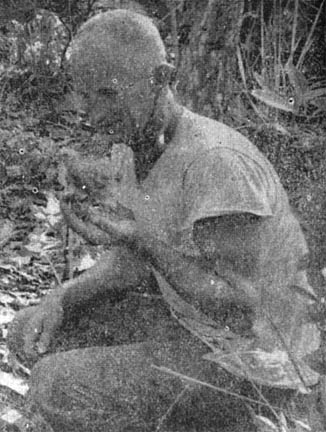 |
Thanks to:
The 25th Infantry Division Museum for providing the volume of 1966 Tropic
Lightning News,
Ron Leonard, 25th Aviation Battalion for finding and mailing them,
Kirk Ramsey, 2nd Bn., 14th Inf. for creating this page.
This page last modified 11-01-2006
©2006 25th Infantry Division Association. All rights reserved.